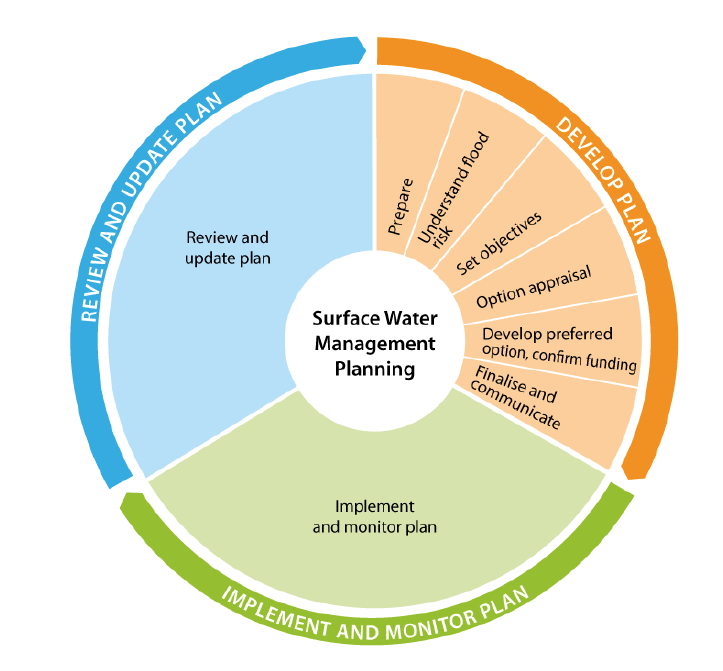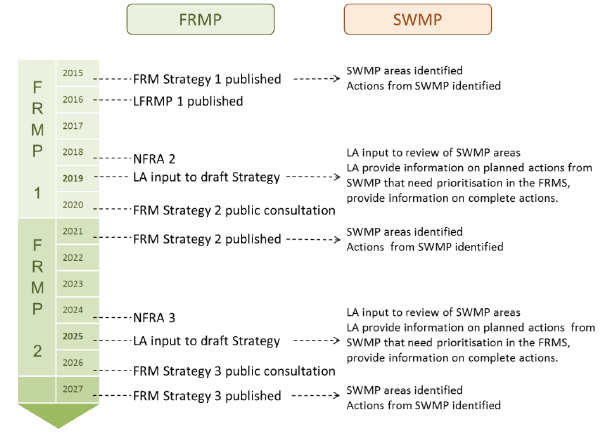Surface water management planning: guidance (2018)
Guidance to assist the responsible authorities in preparation of Surface Water Management Plans (SWMPs) to help with the management of surface water flooding.
2 The surface water management planning process
2.1 Principles of surface water management planning
The aim of a surface water management plan is to reduce the risk of surface water flooding in the most sustainable way, as required under the FRM Act.
Range of sustainable actions
SWMPs are likely to include a range of different actions. These should be the most sustainable combination of actions necessary to manage the risk of surface water flooding (see Appendix 4 for a list of potential actions). The most sustainable actions are those that are the most economically, socially and environmentally advantageous.
SWMPs may also include actions that are the responsibility of different authorities. In such cases, the SWMPS will help to co-ordinate funding and implementation across the relevant authorities. Funding may come from various sources, depending on the cost of implementation and the authority responsible.
Long-term, iterative approach
SWMPs should set out a long-term vision for sustainably managing surface water flooding in an area and the actions needed to achieve that vision. More detailed information is likely to be available for priority actions that will be implemented in the shorter term while less information may be available for longer term actions.
The process should be iterative. SWMPs should be monitored, reviewed and updated with timescales for reviews and updates that take into account the six-year Flood Risk Management Planning cycle. The benefits of adopting a longer term, iterative approach include the ability to:
- Include new data, thereby ensuring that the plan is based on the best available information.
- Monitor how effective actions are that have been implemented and trial innovative solutions.
- Plan for new actions to achieve the long-term vision.
- Adapt to changing circumstances.
- Tackle problems in stages. Surface water flooding is often widespread and fragmented across an urban area so that in many cases it is not feasible to solve all surface water flooding problems at once.
- Co-ordinate with other projects and authorities to realise multiple benefits. It allows different authorities to identify where and when there may be opportunities for co-ordination or joint working. This is more difficult when authorities are focused on their own priorities over the short-term.
- Be more cost-effective. Some surface water management actions may only become cost-effective if implemented alongside other projects. Long-term planning helps to identify where and when this can be done.
Risk-based
Surface water management plans should be risk-based in order that effort and investment can be directed toward areas at greatest risk of flooding and where the most benefits can be achieved.
SWMPs can be carried out at any geographical scale, focusing more detail on areas at greatest risk. For example, an SWMP could be carried out for an entire local authority ( LA) area but should contain more detail on locations within it that have been designated by FRM Strategies as being at higher risk (and any other areas of interest to the local authority). Or, a larger urban area could be covered by many SWMPs.
All stages of the surface water management planning process should be informed by risk. The level of detail to go into at each stage (e.g. number of outputs and detail provided for each output) will depend on a number of factors, including: the level of flood risk; the complexity of the flooding problem; the availability of resources; and, the availability of, and confidence in, existing data.
2.2 Stages of the surface water management planning process
Figure 2.1 and Table 2.1 show the stages to be followed when developing and implementing a surface water management plan. All stages are consistent with the development of the FRM Strategy and the principles of the FRM Act.

Figure 2.1 Stages of the surface water management planning process
Table 2.1 Summary of surface water management planning stages
| SWMP stage | Summary | Example outputs |
|---|---|---|
| Prepare |
|
|
| Understand flood risk |
|
|
| Set objectives |
|
|
| Option appraisal |
|
|
| Develop preferred option, confirm funding |
|
|
| Finalise and communicate plan |
|
|
| Implement and monitor actions |
|
|
| Review and update SWMP |
|
|
2.3 SWMP timescales and flood risk management planning
The flood risk management planning process runs on a six-year cycle, the statutory dates for which are shown in Figure 2.2. Key tasks and dates to consider for surface water management planning are:
- SEPA update of pluvial hazard and risk data – the data should be used to inform (or may trigger) a review and update of surface water management plans. At the time of publication SEPA had no timescale for the next update but it will share the information with responsible authorities when it becomes available.
- More detailed modelling of pluvial flood hazard and risk by LAs – if a local authority has more detailed modelling of pluvial flood hazard and risk it should contact SEPA to determine whether SEPA’s pluvial flood hazard and risk maps should be updated. As the FRM planning process is cyclical, data can be provided to SEPA at any time. That said, key flood risk management planning dates should be considered to allow new data to be included in any National Flood Risk Assessments ( NFRAs) or FRM Strategies: for example, SEPA would need data prior to the publication of an NFRA for it to be incorporated – e.g. by 2018 for FRM Strategy 2, or by 2022 for NFRA 3 (as part of FRMP 3 development).
- Review and update of SWMP areas 2019, 2025 etc. – SEPA, in consultation with LAs and Scottish Water, will lead on reviewing and updating SWMP areas before each six-yearly FRM Strategy public consultation. LAs should therefore share any knowledge of surface water flooding in their area (e.g. based on observed flood events or more detailed modelling) with SEPA. New SWMP areas may be included if information shows there is a greater risk of surface water flooding than was previously identified; conversely existing SWMP areas may be removed where new information shows the risk to be lower.
- Actions (planned and completed) identified through the SWMP 2019, 2025 etc. – in order to inform the FRM Strategy’s prioritisation process and funding decisions, LAs should submit information on any planned actions identified through the SWMP process as requiring prioritisation, before each six-yearly public consultation (i.e. 2019, 2025 etc.). Information on completed actions should be provided for progress to be reported. Any actions relevant to the SWMP and confirmed by other authorities (e.g. Scottish Water) can also be included in time for the FRM Strategy public consultation stage, even if they do not require FRM Strategy prioritisation for funding decisions.

Figure 2.2 Key dates for FRMP and SWMP
Contact
Gordon Robertson: Flooding_Mailbox@gov.scot
There is a problem
Thanks for your feedback